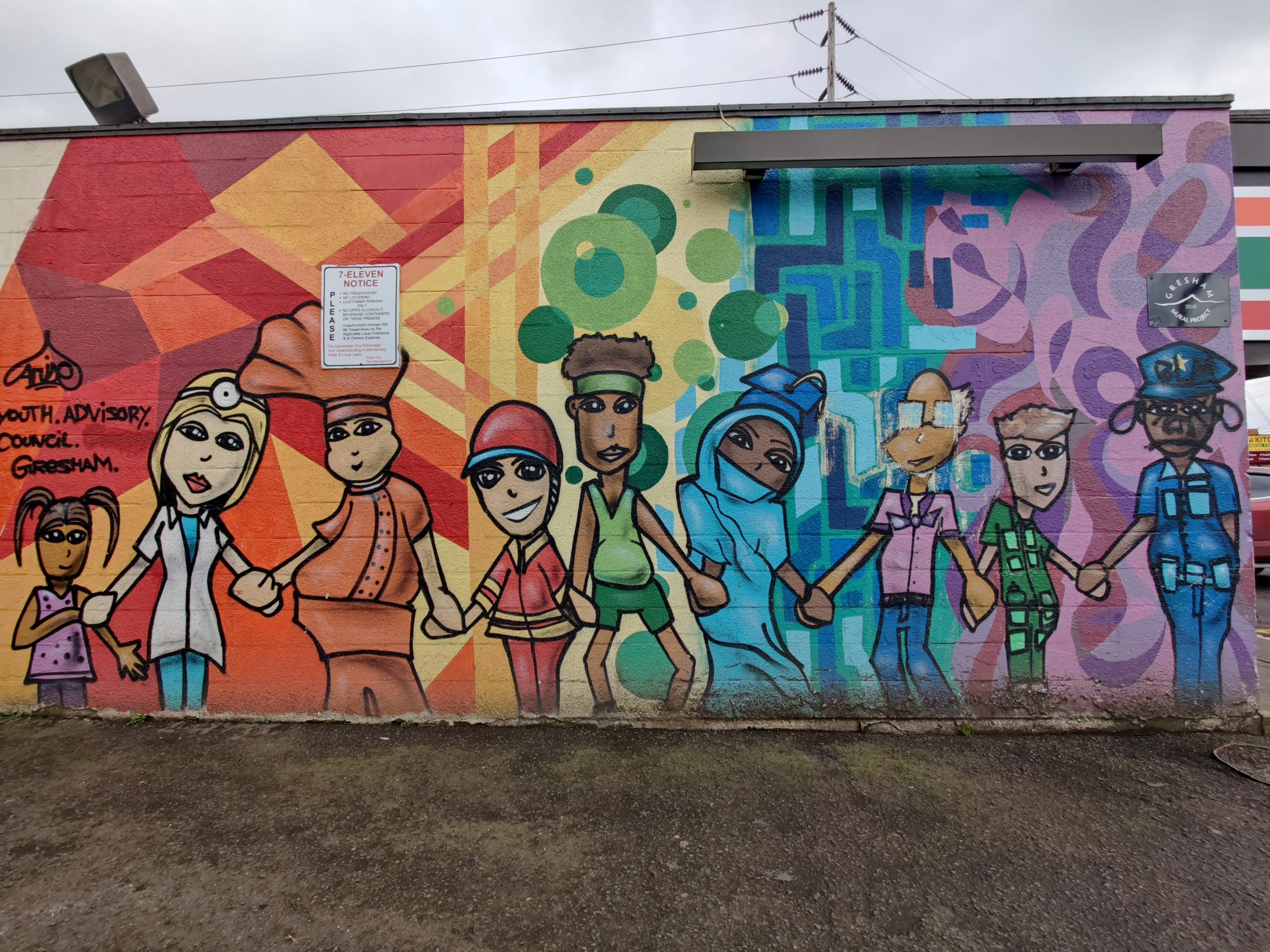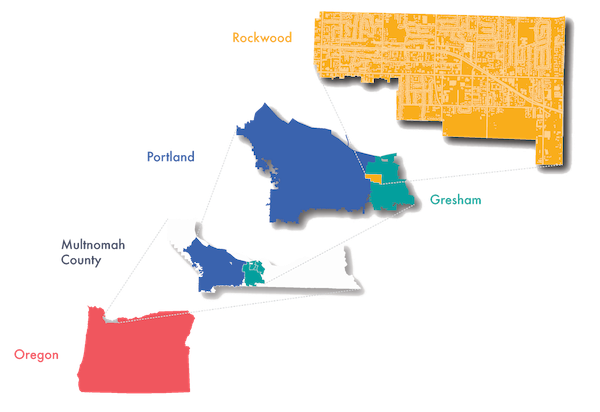Introduction
The Rockwood Identity Atlas is a data collection initiative that aims to provide the Rockwood Community Development Corporation (CDC) with information about the community it serves.

About the Atlas
The Rockwood Identity Atlas is a data collection initiative that aims to provide the Rockwood Community Development Corporation (CDC) with information about the community it serves.
Through maps, data, and stories that highlight the identity, geography, and living conditions of the Rockwood community, this atlas aims to support Rockwood CDC and partner organizations better understand the challenges and opportunities facing the neighborhood.
Although the atlas is an attempt to synthesize a more unified narrative about the identity of Rockwood, the report can be viewed in three distinct sections. We explored the three sections in three phases during March-May 2021:
- Phase I: Existing Conditions Analysis
- Phase II: Community Engagement & Asset Mapping
- Phase II: Rockwood Community Actionable Strategies
The first section is an exploration of social, economic, and health data. The second section details the outcomes of public outreach, focus group interviews, and community asset mapping with Rockwood residents. The third section presents a review of relevant policies and makes recommendations that relate to the findings in the first two sections.
Together, the three sections aim to tell a story of where Rockwood is in relation to Multnomah County and Oregon statewide, what Rockwood residents think of their community, and how Rockwood CDC and partner organizations might approach the opportunities and challenges facing the neighborhood.
The intention of our report is to celebrate the strengths, identify the challenges, and illuminate the opportunities that Rockwood has. Still, our methodology has its limitations. Due to delays in the census, we are only able to analyze data as recent as 2019. Furthermore, no matter how much government data we collect and analyze, the conclusions we draw are only part of Rockwood’s story. The most important—and accurate—depictions of Rockwood come from the people who live and work in Rockwood every day, which is why our analysis includes resident voices through our community engagement activities.
Additionally, the methodology of this project relies heavily on quantitative and qualitative data collection. As university students, we recognize that academia has a long history of extractive and exploitative data practices that have harmed vulnerable communities. Information is power, and while we hope the information provided in this report is illuminative and empowering for Rockwood, we know that information can be used to exacerbate inequality and perpetuate injustice if gathered and used improperly. To that end, our team tried to align our work as closely as possible with the Framework for Research and Data Justice developed by the Coalition for Communities of Color (CCC).
1 For more information on data justice, please visit: https://www.coalitioncommunitiescolor.org/ccc-researchdatajustice
The Rockwood Identity Atlas is a compilation of maps, data, and stories that strive to make the identity, geography, and living conditions of the Rockwood community more visible to public agencies and nonprofits that would serve them.
What is Rockwood?
Defining a community is complex. Are our communities defined by the spaces that we share or the relationships between us?
For the Rockwood neighborhood, there is a degree of ambiguity as to what community and location mean. While Rockwood is located in the city of Gresham, some Gresham residents see Rockwood as part of East Portland. In contrast, people in Portland view Rockwood as a neighborhood in Gresham. Rockwood also sits inside of The Numbers, an area loosely defined as being east of 82nd Ave, or sometimes east of the I-205, characterized by a young, racially/ethnically diverse population, many of whom have been displaced from gentrifying inner-Portland neighborhoods. In Rockwood, some residents have Portland mailing addresses despite having the city of Gresham road crews tend to their streets. Some residents in Rockwood look internally to build social support and community within the neighborhood, and others look for support and a sense of community that reaches beyond Rockwood’s geographic boundaries.
Compared to both Eastern and Western Multnomah County, the population of Rockwood is younger and more racially and ethnically diverse. Despite the strengths and skills held by the residents of Rockwood, most efforts to define the neighborhood use harmful rhetoric focused on needs and challenges, characterizing Rockwood by crime and poverty rates. While Rockwood residents experience greater financial hardship, housing insecurity, and burden of disease than both Eastern and Western Multnomah County, these conditions are not inherent to a place but a product of racial and socioeconomic marginalization.
This spatial dissonance enshrouding the Rockwood neighborhood often leaves its residents feeling overlooked, their strengths unacknowledged, and their needs unaddressed. The Rockwood Identity Atlas, therefore, intends to serve as a collection of community stories, reinforced by existing information, to build a narrative surrounding what Rockwood is from the perspective of those living there, explore the strengths and knowledge held by residents, and the factors that have determined its contemporary state.
Officially, Rockwood is a neighborhood in Gresham, Oregon. Rockwood is also a name that refers to the region that spans parts of east Portland and west Gresham.
Where is Rockwood Located?
This illustration shows how Rockwood is situated in the state of Oregon. Note: throughout this report, we often reference this color scheme. So look for yellow—that’s Rockwood.

Equity Statement
UCC is committed to prioritizing populations and the perspectives of those who experience historical and systemic oppression and discrimination, including Native and Indigenous people, People Living in Poverty, People of Color, People with Disabilities, LGBT2SQIA+ people, Immigrants & Refugees, People speaking English as a Second Language (ESL), Religious Minorities, Older Adults, Women, Youth, Houseless populations, all other groups who continue to experience marginalization in the United States.
Structural Equity: What historic advantages or disadvantages have affected residents in the given community?
Our efforts on addressing structural equity are done through recalling and recognizing neighborhood history and analyzing how policies have determined the current conditions experienced by neighborhood residents.
Procedural Equity: How are residents who have been historically excluded from planning processes being authentically included in the planning, implementation, and evaluation of the proposed policy or project?
Procedural equity is an integral piece of our scope of work and motivation for this project. At UCC we see our work as a means to move addressing community concerns “upstream”, towards policy-level initiatives. We use mapping and collaborative processes to define community and identity.
Distributional Equity: Does the distribution of civic resources and investment explicitly account for potential racially disparate outcomes?
To address distributional equity, we aim to understand existing conditions, patterns of investment, resources, policies, and the community definition of resources and assets. Our focus here intends to shed light on issues impacting distributional equity in Rockwood.
Transgenerational Equity: Does the policy or project result in unfair burdens on future generations?
We recognize the temporality that an identity project can create. We acknowledge the fact that the identity of today’s Rockwood might not be the same in the future. In this sense, we intend to include the perspectives of youth as well as the elderly in specific activities in our engagement process, and as key actors of this collective process.
Acknowledgements
Portland State University
- Dr. Megan Horst
- Professor Irene Kim
- Dr. Lisa Bates
- Francisco Ibarra
- Max Nonnamaker
- Phil Longenecker
- Ana Navia
- Natalie Chavez
- Heidi Hinshaw
- Tanja Olson
- Eric Trinh
Organizations
- Latino Network
- La Tapatia Market
- New Avenues for Youth
- Mapping Action Collective
- Wallace
Rockwood CDC
- Dr. David Sahu
The Rockwood Identity Atlast was compiled in partnership with the following individuals, organizations, and groups.